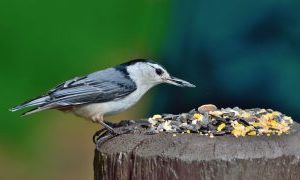 You may have noticed a loud, sweetly-whistled “Spring’s here!” in recent weeks. This is the song of the Black-capped Chickadee (as is the three-parted “Cheese-bur-ger!”).
You may have noticed a loud, sweetly-whistled “Spring’s here!” in recent weeks. This is the song of the Black-capped Chickadee (as is the three-parted “Cheese-bur-ger!”).
Many of our year-round bird residents are cavity nesters. Chickadees, nuthatches, and some woodpeckers stay here through the winter, and they’ll start their courtship activities in March.
Chickadees
Black-capped Chickadees excavate their nest holes in soft, rotten wood. As they excavate, they carry the chips away from beneath the hole to keep the location of their nest secret from potential predators. Chickadees will also use nesting boxes, so now’s the time to put them out close to or within the cover of a bush or small tree if you have them. If not, we carry several nest-boxes from Animal House Creations.
Nuthatches
Both Nuthatch species (Red-breasted and White-breasted) breed in Peterborough. The songs of both nuthatches are nasal, monotonous, and repeated. The Red-breasted’s sounds like a tiny toy horn, and the White-breasted’s is a loud “Hank!” or “Nuthatch!”. Red-breasts prefer conifers, and White-breasts prefer deciduous trees.
Woodpeckers
Three woodpecker species common in Peterborough stay here throughout the winter. Songbirds use song to define their territories and attract mates. Woodpeckers use their beaks to drum on branches, hydro poles, and sometimes metal signs and downspouts for this purpose. The large Pileated Woodpecker needs large dead trees for nesting but can often be seen drumming on hydro poles. To me, the Pileated’s drum sounds like a large pirate ship creaking as it rocks slowly at a wharf. Downy and Hairy Woodpeckers have a very fast drum, and it’s extremely difficult to tell them apart by ear. In all three species, the drumming sound is distinctly different from the more erratic pecking sounds associated with excavating a nest or feeding.
The two other woodpecker species that are common to the area in summer migrate south for the winter. The Norther Flicker feeds primarily on ants, which it can’t access here during the winter months, and the Yellow-bellied Sapsucker relies heavily on flowing sap to drink and to trap insects for food. The Flicker’s drum sounds pretty much the same as the Downy’s and Hairy’s drum. The Sapsucker’s drum starts as fast and explosive and slows down and gets quieter, as though he’s running out of steam after such an intense start.
Lending a Hand
It’s exciting to see and hear hints of spring while there’s still snow on the ground. Keep your eyes and ears open! You can help the cavity nesters in your yard in several ways:
- Keep a supply of high-quality sunflower seeds available at your feeder for Chickadees and Nuthatches.
- Set up a suet feeder to provide woodpeckers with some extra energy to fuel all that drumming and excavating.
- If you ever need to have a large tree removed from your yard, leave the main trunk in place (called a snag”). As the snag decays, the insects living in it provide a great food source, and the snag itself may end up becoming a nesting tree someday.
